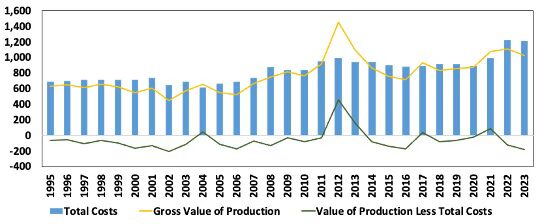By Yangxuan Liu and Amanda Smith
Besides cotton, another primary row crop suitable to southern soils and the climate is peanuts. As a legume, peanuts are often used as a rotational crop with cotton and/or corn. Peanuts are grown primarily in the southeastern U.S. from Virginia down to Florida and over to Alabama, with some acreage as far west as New Mexico, Texas, and Oklahoma. In 2024, the U.S. is projected to produce 3.2 million farmer stock tons of peanuts (USDA ERS). Market year average prices are expected to be around $530 per ton (USDA FSA), and if realized, the projected total value of peanut production is expected to be $1.7 billion. Not only are peanuts an important rotational crop, but they also contribute significantly to the rural farm economies of the Southern region.
Peanuts are capital intensive particularly because of the specific harvest equipment that must be used to dig up the vines. Then after the vines dry, another machine picks the peanuts from the vines. Analysis of data from the USDA Economic Research Service illustrates the financial challenge of the rising costs of peanut farming. Figure 1 highlights the ongoing profitability challenges southern peanut farmers have faced over the last 29 years. These data account for actual production costs incurred during the production process by farm operators, landlords, and contractors and include expenses for labor, equipment, and other inputs. Revenues generated from peanut sales are also analyzed. The revenues do not include government payments and crop insurance indemnities received by producers. Potential government payments during this time period may include traditional farm bill programs for farmers with base acres, as well as ad-hoc disaster relief programs.
According to Figure 1, the average peanut farmer managed to earn a profit in only five of the last twenty-nine years. On average, peanut growers faced annual losses of $57 per acre. Referring back to the companion article linked above, cotton farmers also faced average annual losses of $94 per acre during this same time period. These long-run average losses per acre show the continued financial challenges incurred by southern farmers despite growing crops that are suitable for the regional climate and soils. As with cotton, long-term economic losses to peanut production put the sustainability of Southern agriculture at risk. A continuation of these trends could result in a prolonged decline in agricultural production, eroding the economic foundation of rural farming communities across the Southern region. It is evident that there continues to be a need for effective agricultural policies and support programs.
Figure 1. Peanut Production Total Costs, Revenue, and Returns for Producers in the United States (1995 – 2023).

Click here to see more...